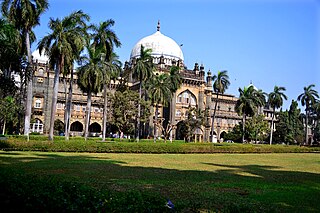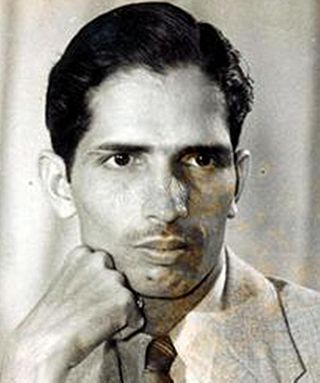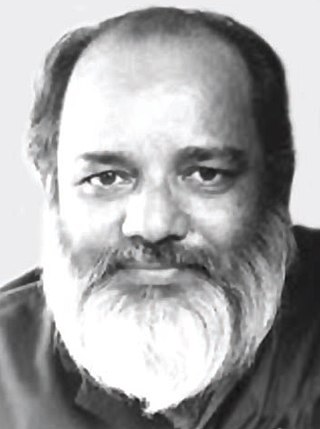
Chhatrapati Shivaji Maharaj Vastu Sangrahalaya, (CSMVS) originally named Prince of Wales Museum of Western India, is a museum in Mumbai (Bombay) which documents the history of India from prehistoric to modern times.

Mulk Raj Anand was an Indian writer in English, recognised for his depiction of the lives of the poorer castes in traditional Indian society. One of the pioneers of Indo-Anglian fiction, he, together with R. K. Narayan, Ahmad Ali and Raja Rao, was one of the first India-based writers in English to gain an International readership. Anand is admired for his novels and short stories, which have acquired the status of classics of modern Indian English literature; they are noted for their perceptive insight into the lives of the oppressed and for their analysis of impoverishment, exploitation and misfortune. He became known for his protest novel Untouchable (1935), followed by other works on the Indian poor such as Coolie (1936) and Two Leaves and a Bud (1937). He is also noted for being among the first writers to incorporate Punjabi and Hindustani idioms into English, and was a recipient of the civilian honour of the Padma Bhushan.

Kala Ghoda is a crescent-shaped art district/neighborhood in Mumbai, India. It hosts several of the city's heritage buildings including museums, art galleries and educational institutions like the Chhatrapati Shivaji Maharaj Vastu Sangrahalaya, the Jehangir Art Gallery, the National Gallery of Modern Art, and The Arts Trust - Institute of Contemporary Indian Art.

Elphinstone College is one of the constituent colleges of Dr. Homi Bhabha State University, a state cluster university. Established in 1823, it is one of the oldest colleges in Mumbai. It played a major role in shaping and developing the educational landscape of the city. It also played a pivotal role in the inception of the University of Mumbai.

Jan Nisar Akhtar was an Indian poet of Urdu ghazals and nazms, and a part of the Progressive Writers' Movement, who was also a lyricist for Bollywood.

The National Centre for the Performing Arts (NCPA) is a multi-venue, multi-purpose cultural centre in Mumbai, India, which aims to promote and preserve India's heritage of music, dance, theatre, film, literature and photography. It also presents new and innovative work in the performing arts field.

Bhanu Athaiya was an Indian costume designer and painter. She was the first Indian to win an Academy Award. Alongside being Bollywood's most iconic costume designer, she had a historically important early career as an artist with contemporaries like M. F. Husain, F. N. Souza and Vasudeo S. Gaitonde. She was the only woman member of the Bombay Progressive Artists' Group. Two of Bhanu Rajopadhye's artworks were included in the 1953 Progressive Artists' Group show in Bombay.

Akbar Padamsee was an Indian artist and painter, considered one of the pioneers in modern Indian painting along with S.H. Raza, F.N. Souza and M.F. Husain. Over the years he also worked with various mediums from oil painting, plastic emulsion, water colour, sculpture, printmaking, to computer graphics, and photography. In addition, he worked as a film maker, sculptor, photographer, engraver, and lithographer. Today his paintings are among the most valued by modern Indian artists. His painting Reclining Nude was sold for US$1,426,500 at Sotheby's in New York on 25 March 2011.
Esther David is an Indian Jewish author, an artist and a sculptor. She is a recipient of the Sahitya Akademi Award.
Romesh Thapar (1922–1987) was an Indian journalist and political commentator. Affiliated with the Communist Party of India (Marxist), Thapar was the founder-editor of the monthly journal Seminar, published from New Delhi, India.
The history of the Jews in Mumbai, India, began when Jews started settling in Bombay during the first century, due to its economic opportunities. The Jewish community of Bombay consisted of the remnants of three distinct communities: the Bene Israeli Jews of Konkan, the Baghdadi Jews of Iraq, and the Cochin Jews of Malabar.

Kattingeri Krishna Hebbar was an Indian painter and art educator. He is well known for his paintings that captured the social life of the common people in India. Inspired by traditional Indian art, he combined the Western art techniques with his paintings to create a unique style of his own. Painting for Hebbar was about being true to the original self and this is what he tried to achieve in his works. In addition to his paintings, he is also known for his rhythmic line drawings and illustrations.
Saros Dara Cowasjee was an Indian-born Canadian novelist, short story writer, commentator, critic, anthologist, and screenwriter, as well as a professor emeritus at University of Regina.

Amar Nath Sehgal was a noted Indian modernist sculptor, painter, poet and art educator. He started his career as an engineer in Lahore, and later turned to art. He shifted to Delhi after partition of India in 1947, and in 1950 studied art education from New York University School of Education. Subsequently, became an art educator, teaching at College of Art, Delhi, and in time a noted modern sculptor to his generation. Though he also ventured into painting, drawings and poetry.

Vidya Dehejia is a retired American academic and the Barbara Stoler Miller Professor Emerita of Indian and South Asian Art at Columbia University. She has published 24 books and numerous academic papers on the art of South Asia, and has curated many exhibitions on the same theme.

Sadashiv Vasantrao Gorakshkar was an Indian writer, art critic, historian, museologist and a director of the Chhatrapati Shivaji Maharaj Vastu Sangrahalaya, erstwhile Prince of Wales Museum, Mumbai. He is credited with the restoration of Lakshmibai Pitre Kalasangrahalaya, a museum in Devrukh, Maharashtra to its present state.
Anil de Silva (1909–1996), known as Anil (Marcia) de Silva-Vigier, was a Sri Lankan journalist, political activist, author, art critic, and art historian. She worked for Marg, a quarterly Indian journal on traditional and modern art, and was co-editor of the children's magazine Toycart; She founded the Indian People's Theatre Association, was associated with the Indian Communist party, and was considered Bombay's avant-garde. In 1958 she launched an expedition to China to study cave paintings. She published several books, of which the most prominent were: The Life of the Buddha Through Painting and Sculpture (1955), The Art of Chinese Landscape Painting: In the Caves of Tun-huang, (1964) and This Moste Highe Prince: John of Gaunt, 1340-1399. She also co-edited a series on "Man Through His Art" for UNESCO.
Shirin Vajifdar was an Indian classical dancer, choreographer, instructor and critic. She was one of the first Parsis who took up Indian classical dance. A doyenne of Kathak, she was an acclaimed performer and teacher. Her choreography in the film Mayurpankh (1954) was lauded.

Baburao Sadwelkar was an Indian painter, art writer, educator and administrator. He is known for his portraits, landscape and abstract paintings in the Impressionistic style. As an art educator, he brought a modern outlook to art education at the Sir J. J. School of Art after learning about the American art education model under a Fulbright Scholarship in 1962–63. Sadwelkar was also passionate about the art tradition of Maharashtra and the art history of the Sir J. J. School of Art. From 1975 to 1986, he served as the Director of Art for Maharashtra State where the preservation and propagation of this artistic tradition prospered under his guidance. He wrote extensively about the art and artists from the state and which are considered as important art publications.

Shiavax Dhanjibhoy Chavda was an Indian painter, illustrator and muralist. Known for his dynamic line drawings and paintings, Chavda's work mainly showcased the dancers and musicians from India and Southeast Asia.















